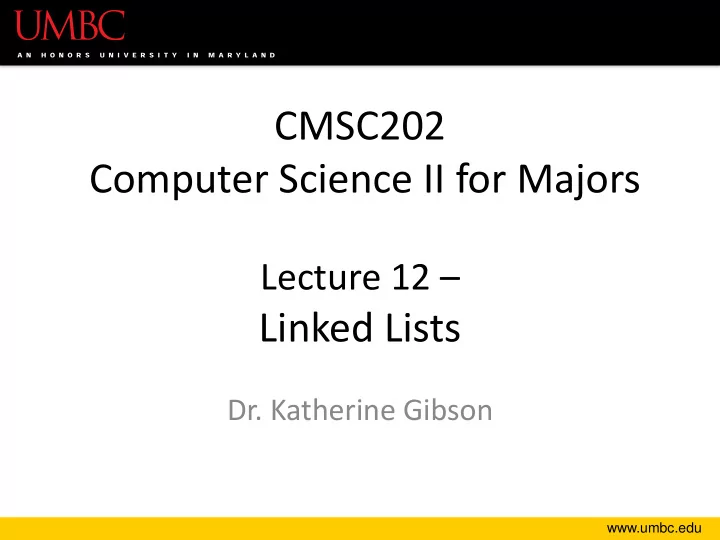

CMSC202 Computer Science II for Majors Lecture 12 – Linked Lists Dr. Katherine Gibson www.umbc.edu
Last Class We Covered • Inheritance • Object relationships – is-a (Inheritance) – has-a (Composition and Aggregation) 2 www.umbc.edu
Any Questions from Last Time? www.umbc.edu
Today’s Objectives • To cover linked lists in detail – Traversal – Creation – Insertion – Deletion 4 www.umbc.edu
Linked Lists vs Vectors www.umbc.edu
What is a Linked List? • Data structure – Dynamic – Allow easy insertion and deletion • Uses nodes that contain – Data – Pointer to next node in the list 6 www.umbc.edu
Example Linked List In these diagrams, a doubly- outlined box indicates a pointer. head tail data data data data link link link link NULL 7 www.umbc.edu
Why Use Linked Lists? • We already have vectors! • What are some disadvantages of an vectors? – Inserting in the middle of an array takes time – Deletion as well – Sorting – Requires a contiguous block of memory 8 www.umbc.edu
Representation in Memory Each cell is a Array location block of memory in memory First node of Linked List NULL 9 www.umbc.edu
(Dis)Advantages of Linked Lists • Advantages: – Change size easily and constantly – Insertion and deletion can easily happen anywhere in the Linked List – Only one node needs to be contiguously stored • Disadvantages: – Can’t access by index value – Requires management of memory – Pointer to next node takes up more memory 10 www.umbc.edu
Nodes www.umbc.edu
Nodes • A node is one element of a Linked List • Nodes consist of two main parts: – Data stored in the node data – Pointer to next node in list link • Often represented as classes 12 www.umbc.edu
Code for Node Class class Node { name String name; testGrade int testGrade; link Node *link; NULL // constructor link can point to other nodes // accessors two options: // mutators 1. another Node }; 2. NULL 13 www.umbc.edu
Linked List Overview www.umbc.edu
15 www.umbc.edu
Example Linked List link m_head name DUMMY name name testGrade DUMMY testGrade testGrade link link link link NULL 16 www.umbc.edu
Important Points to Remember • Last node in the Linked List points to NULL • Each node points to either another node in the Linked List, or to NULL – Only one link per node 17 www.umbc.edu
Managing Memory with LLs • Hard part of using Linked Lists is ensuring that none of the nodes go “missing” • Think of Linked List as a train – (Or as a conga line of Kindergarteners) • Must keep track of where links point to • If you’re not careful, nodes can get lost in memory (and you have no way to find them) 18 www.umbc.edu
Linked List Functions • What functions does a Linked List class implementation require? • Linked_List constructor • insert() • remove() • printList() • isEmpty() 19 www.umbc.edu
Linked Lists’ “Special” Cases • Linked Lists often need to be handled differently under specific circumstances – Linked List is empty – Linked List has only one element – Linked List has multiple elements – Changing something with the first or last node • Keep this in mind when you are coding – Dummy nodes alleviate some of these concerns 20 www.umbc.edu
Creating a Linked List 21 www.umbc.edu
Traversing the List • To control our traversal, we’ll use a loop – Initialization, Termination Condition, Modification 1. Set CURR to the first node in the list 2. Continue until we hit the end of the list ( NULL ) 3. Move from one node to another (using m_next ) www.umbc.edu
Demonstration of Traversal NULL FRONT CURR DUMMY Bob Eve DUMMY 91 94 link link link NULL for (CURR = FRONT; CURR != NULL; CURR = CURR->link) { www.umbc.edu
Demonstration of Traversal FRONT CURR DUMMY Bob Eve DUMMY 91 94 link link link NULL for (CURR = FRONT; CURR != NULL; CURR = CURR->link) { www.umbc.edu
Demonstration of Traversal FRONT CURR DUMMY Bob Eve DUMMY 91 94 link link link NULL for (CURR = FRONT; CURR != NULL; CURR = CURR->link) { // ignore, dummy node www.umbc.edu
Demonstration of Traversal FRONT CURR DUMMY Bob Eve DUMMY 91 94 link link link NULL for (CURR = FRONT; CURR != NULL; CURR = CURR->link) { www.umbc.edu
Demonstration of Traversal FRONT CURR DUMMY Bob Eve DUMMY 91 94 link link link NULL for (CURR = FRONT; CURR != NULL; CURR = CURR->link) { www.umbc.edu
Demonstration of Traversal FRONT CURR DUMMY Bob Eve DUMMY 91 94 link link link NULL for (CURR = FRONT; CURR != NULL; CURR = CURR->link) { // print information (Bob) www.umbc.edu
Demonstration of Traversal FRONT CURR DUMMY Bob Eve DUMMY 91 94 link link link NULL for (CURR = FRONT; CURR != NULL; CURR = CURR->link) { www.umbc.edu
Demonstration of Traversal FRONT CURR DUMMY Bob Eve DUMMY 91 94 link link link NULL for (CURR = FRONT; CURR != NULL; CURR = CURR->link) { www.umbc.edu
Demonstration of Traversal FRONT CURR DUMMY Bob Eve DUMMY 91 94 link link link NULL for (CURR = FRONT; CURR != NULL; CURR = CURR->link) { // print information (Eve) www.umbc.edu
Demonstration of Traversal FRONT CURR DUMMY Bob Eve DUMMY 91 94 link link link NULL for (CURR = FRONT; CURR != NULL; CURR = CURR->link) { www.umbc.edu
Demonstration of Traversal NULL FRONT CURR DUMMY Bob Eve DUMMY 91 94 link link link NULL for (CURR = FRONT; CURR != NULL; CURR = CURR->link) { www.umbc.edu
Demonstration of Traversal NULL FRONT CURR DUMMY Bob Eve DUMMY 91 94 link link link NULL for (CURR = FRONT; CURR != NULL; CURR = CURR->link) { } // exit the loop www.umbc.edu
Insertion and Deletion 35 www.umbc.edu
Announcements • Project 3 is out – get started now! – It is due Thursday, March 31st 36 www.umbc.edu
Recommend
More recommend